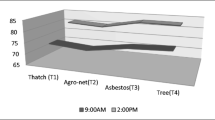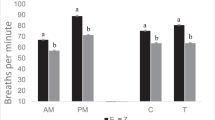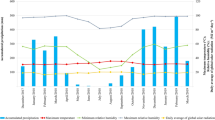Abstract
Under temperate climates, cattle are often at pasture in summer and are not necessarily provided with shade. We aimed at evaluating in a temperate region (Belgium) to what extent cattle may suffer from heat stress (measured through body temperature, respiration rate and panting score, cortisol or its metabolites in milk, and feces on hot days) and at assessing the potential benefits of shade. During the summer of 2012, 20 cows were kept on pasture without access to shade. During the summer of 2011, ten cows had access to shade (young trees with shade cloth hung between them), whereas ten cows had no access. Climatic conditions were quantified by the Heat Load Index (HLI). In animals without access to shade respiration rates, panting scores, rectal temperatures, and milk cortisol concentrations increased as HLI increased in both 2011 and 2012. Fecal cortisol metabolites varied with HLI in 2011 only. When cattle had access to shade, their use of shade increased as the HLI increased. This effect was more pronounced during the last part of the summer, possibly due to better acquaintance with the shade construction. In this case, shade use increased to 65% at the highest HLI (79). Shade tempered the effects on respiration, rectal temperature, and fecal cortisol metabolites. Milk cortisol was not influenced by HLI for cows using shade for > 10% of the day. Therefore, even in temperate areas, cattle may suffer from heat when they are at pasture in summer and providing shade can reduce such stress.





Similar content being viewed by others
References
Becerril CM, Wilcox CJ, Lawlor TJ, Wiggans OR, Webb DW (1993) Effects of percentage of white coat color on Holstein production and reproduction in a subtropical environment. J Dairy Sci 76(8):2286–2291. https://doi.org/10.3168/jds.S0022-0302(93)77565-7
Berman A, Horovitz T (2012) Radiant heat loss, an unexploited path for heat stress reduction in shaded cattle. J Dairy Sci 95:3021–3031. https://doi.org/10.3168/jds.2011-4844
Cena K, Monteith JL (1975) Transfer processes in animal coats. I Radiative Transfer Proc R Soc Lond B Biol Sci 188(1093):377–393. https://doi.org/10.1098/rspb.1975.0026
Christison GI, Johnson HD (1972) Cortisol turnover in heat-stressed cows. J Anim Sci 35(5):1005–1010. https://doi.org/10.2527/jas1972.3551005x
Collier RJ, Doelger SG, Head HH, Thatcher WW, Wilcox CJ (1982) Effects of heat-stress during pregnancy on maternal hormone concentrations, calf birth-weight and postpartum milk-yield of Holstein cows. J Anim Sci 54(2):309–319. https://doi.org/10.2527/jas1982.542309x
Gantner V, Mijic P, Jovanovac S, Raguz N, Bobic T, Kuterovac K (2012) Influence of temperature-humidity index (THI) on daily production of dairy cows in Mediterranean region in Croatia. In: Casasús I, Rogošiç J, Rosati A, Štokoviç I, Gabiña D (eds) Animal Farming and Environmental Interactions in the Mediterranean Region, vol 131. EAAP, pp 71–78
Gaughan JB, Holt SM, Hahn GL, Mader TL, Eigenberg R (2000) Respiration rate—is it a good measure of heat stress in cattle? Asian Australas J Anim Sci 13:329–332
Gaughan JB, Mader TL, Holt SM, Lisle A (2008) A new heat load index for feedlot cattle. J Anim Sci 86(1):226–234. https://doi.org/10.2527/jas.2007-0305
Hahn GL, Mader TL, Eigenberg RA (2003) Perspective on development of thermal indices for animal studies and management. In: Lacettera N, Bermabucci U, Khalifa HH, Ronchi B, Nardone A (eds) Interactions between climate and animal production. EAAP technical series, vol 7. pp 31–44
Hansen PJ (1990) Effects of coat color on physiological-responses to solar-radiation in Holsteins. Vet Rec 127(13):333–334
Haskell MJ, Rennie LJ, Bowell VA, Bell MJ, Lawrence AB (2006) Housing system, milk production, and zero-grazing effects on lameness and leg injury in dairy cows. J Dairy Sci 89(11):4259–4266. https://doi.org/10.3168/jds.S0022-0302(06)72472-9
Hernandez-Mendo O, von Keyserlingk MAG, Veira DM, Weary DM (2007) Effects of pasture on lameness in dairy cows. J Dairy Sci 90(3):1209–1214. https://doi.org/10.3168/jds.S0022-0302(07)71608-9
Johnson H, Ragsdale A, Berry I, Shanklin M (1963 ) Temperature-humidity effects including influence of acclimation in feed and water consumption of Holstein cattle Missouri Agricultural Experiment Station Research Bulletin 846, Columbia
Kadzere CT, Murphy MR, Silanikove N, Maltz E (2002) Heat stress in lactating dairy cows: a review. Livest Prod Sci 77(1):59–91. https://doi.org/10.1016/s0301-6226(01)00330-x
Kendall PE, Nielsen PP, Webster JR, Verkerk GA, Littlejohn RP, Matthews LR (2006) The effects of providing shade to lactating dairy cows in a temperate climate. Livest Sci 103(1-2):148–157. https://doi.org/10.1016/j.livsci.2006.02.004
Mormède P, Andanson S, Aupérin B, Beerda B, Guémené D, Malmkvist J, Manteca X, Manteuffel G, Prunet P, van Reenen CG, Richard S, Veissier I (2007) Exploration of the hypothalamic-pituitary-adrenal function as a tool to evaluate animal welfare. Physiol Behav 92(3):317–339. https://doi.org/10.1016/j.physbeh.2006.12.003
Mostl E, Palme R (2002) Hormones as indicators of stress. Domest Anim Endocrin 23(1-2):67–74. https://doi.org/10.1016/s0739-7240(02)00146-7
Muller CJC, Botha JA, Coetzer WA, Smith WA (1994a) Effect of shade on various parameters of Friesian cows in a Mediterranean climate in South-Africa .2. Physiological-responses. S Afr J Anim Sci 24:56–60
Muller CJC, Botha JA, Smith WA (1994b) Effect of shade on various parameters of Friesian cows in a Mediterranean climate in South-Africa .1. Feed and water-intake, milk-production and milk-composition. S Afr J Anim Sci 24:49–55
Nienaber JA, LeRoy Hahn G Engineering and management practices to ameliorate livestock heat stress. In: International symposium of CIGR New Trends in Farm Buildings, Evora, 2004
Palme R (2012) Monitoring stress hormone metabolites as a useful, non-invasive tool for welfare assessment in farm animals. Anim Welfare 21:331–337. https://doi.org/10.7120/09627286.21.3.331
Palme R, Mostl E (1997) Measurement of cortisol metabolites in faeces of sheep as a parameter of cortisol concentration in blood. Z Sáugetierkunde 62:192–197
Palme R, Robia C, Baumgartner W, Mostl E (2000) Transport stress in cattle as reflected by an increase in faecal cortisol metabolite concentrations. Vet Rec 146(4):108–109
Palme R, Robia C, Messmann S, Hofer J, Möstl E (1999) Measurement of fecal cortisol metabolites in ruminants: a non-invasive parameter of adrenocortical function. Wien Tierarztl Monatsschr 86:237–241
Palme R, Touma C, Arias N, Dominchin MF, Lepschy M (2013) Steroid extraction: get the best out of faecal samples. Wien Tierarztl Monatsschr 100:238–246
Phillips CJC, Beerda B, Knierim U, Waiblinger S, Lidfors L, Krohn CC, Canali E, Valk H, Veissier I, Hopster H (2013) A review of the impact of housing on dairy cow behaviour, health and welfare. In: Aland A, Banhazi T (eds) Livestock housing: modern management to ensure optimal health and welfare of farm animals. Wageningen Academic Publishers, pp 37–54. https://doi.org/10.3920/978-90-8686-771-4_02
Rees A, Fischer-Tenhagen C, Heuwieser W (2016) Effect of heat stress on concentrations of faecal cortisol metabolites in dairy cows. Reprod Domest Anim 51(3):392–399. https://doi.org/10.1111/rda.12691
Reijs JW, Daatselaar CHG, Helming JFM, Jager J, Beldman ACG (2013) Grazing dairy cows in North-West Europe; economic farm performance and future developments with emphasis on the Dutch situation LEI Report 2013–001, p 124. http://library.wur.nl/WebQuery/wurpubs/fulltext/265398
Rosselle L, Permentier L, Verbeke G, Driessen B, Geers R (2013) Interactions between climatological variables and sheltering behavior of pastoral beef cattle during sunny weather in a temperate climate. J Anim Sci 91(2):943–949. https://doi.org/10.2527/jas.2012-5415
Schutz KE, Cox NR, Tucker CB (2014) A field study of the behavioral and physiological effects of varying amounts of shade for lactating cows at pasture. J Dairy Sci 97(6):3599–3605. https://doi.org/10.3168/jds.2013-7649
Schutz KE, Rogers AR, Poulouin YA, Cox NR, Tucker CB (2010) The amount of shade influences the behavior and physiology of dairy cattle. J Dairy Sci 93(1):125–133. https://doi.org/10.3168/jds.2009-2416
Senft RL, Rittenhouse LR (1985) A model of thermal-acclimation in cattle. J Anim Sci 61(2):297–306. https://doi.org/10.2527/jas1985.612297x
Shoshani E, Hetzroni A (2013) Optimal barn characteristics for high-yielding Holstein cows as derived by a new heat-stress model. Anim Behav Abst 7:176–182
Silanikove N (2000) Effects of heat stress on the welfare of extensively managed domestic ruminants. Livest Prod Sci 67:1–18
Thun R, Eggenberger E, Zerobin K, Luscher T, Vetter W (1981) 24-hour secretory pattern of cortisol in the bull—evidence of episodic secretion and circadian-rhythm. Endocrinology 109(6):2208–2212. https://doi.org/10.1210/endo-109-6-2208
Tucker CB, Rogers AR, Schutz KE (2008) Effect of solar radiation on dairy cattle behaviour, use of shade and body temperature in a pasture-based system. Appl Anim Behav Sci 109:141–154. https://doi.org/10.1016/j.applanim.2007.03.015
Tuyttens FAM, de Graaf S, Heerkens JLT, Jacobs L, Nalon E, Ott S, Stadig L, van Laer E, Ampe B (2014) Observer bias in animal behaviour research: can we believe what we score, if we score what we believe? Anim Behav 90:273–280. https://doi.org/10.1016/j.anbehav.2014.02.007
Umphrey JE, Moss BR, Wilcox CJ, Van Horn HH (2001) Interrelationships in lactating Holsteins of rectal and skin temperatures, milk yield and composition, dry matter intake, body weight, and feed efficiency in summer in Alabama. J Dairy Sci 84:2680–2685
Valtorta S, Leva P, Gallardo M (1997) Evaluation of different shades to improve dairy cattlewell-being in Argentina. Int J Biometeorol 41(2):65–67
Van Laer E, Moons CPH, Ampe B, Sonck B, Vandaele L, De Campeneere S, FAM T (2015a) Effect of summer conditions and shade on behavioural indicators of thermal discomfort in Holstein dairy and Belgian Blue beef cattle on pasture. Animal 9(09):1536–1546. https://doi.org/10.1017/S1751731115000804
Van Laer E, Moons CPH, Ampe B, Sonck B, Vangeyte J, FAM T (2015b) Summertime use of natural versus artificial shelter by cattle in nature reserves. Anim Welfare 24(3):345–356. https://doi.org/10.7120/09627286.24.3.345
Van Laer E, Moons CPH, Sonck B, FAM T (2014) Importance of outdoor shelter for cattle in temperate climates. Livest Sci 159:87–101. https://doi.org/10.1016/j.livsci.2013.11.003
Van Laer E, Tuyttens FAM, Ampe B, Sonck B, Vandaele L (2015c) Effect of summer conditions and shade on the production and metabolism of Holstein dairy cows on pasture in temperate climate. Animal 9:1547–1558
Veissier I, Andanson S, Dubroeucq H, Pomiès D (2008) The motivation of cows to walk as thwarted by tethering. J Anim Sci 86(10):2723–2729. https://doi.org/10.2527/jas.2008-1020
Verkerk GA, Phipps AM, Carragher JF, Matthews LR, Stelwagen K (1998) Characterization of milk cortisol concentrations as a measure of short-term stress responses in lactating dairy cows. Anim Welfare 7:77–86
West JW, Mullinix BG, Bernard JK (2003) Effects of hot, humid weather on milk temperature, dry matter intake, and milk yield of lactating dairy cows. J Dairy Sci 86:232–242. https://doi.org/10.3168/jds.S0022-0302(03)73602-9
Yasothai R (2014) Effect of climate on nutrient intake and metabolism and countering heat stress by nutritional manipulation. Int J Environ Sci Te 3:1685–1690
Acknowledgements
We thank the animal caretakers and technicians at the ILVO Animal Sciences Unit (especially Seppe Holemans, Sara Van Lembergen, and Thijs Decroos) and master student Evelien Van de Keere. Thanks also to Edith Klobetz-Rassam and to Christine Ravel for steroid analyses and to Miriam Levenson (ILVO) for English-language editing.
Funding
This study was funded by the Federal Public Service of Health, Food Chain Safety and Environment (contract RT 10/13 Pastress).
Author information
Authors and Affiliations
Corresponding authors
Rights and permissions
About this article
Cite this article
Veissier, I., Van laer, E., Palme, R. et al. Heat stress in cows at pasture and benefit of shade in a temperate climate region. Int J Biometeorol 62, 585–595 (2018). https://doi.org/10.1007/s00484-017-1468-0
Received:
Revised:
Accepted:
Published:
Issue Date:
DOI: https://doi.org/10.1007/s00484-017-1468-0




